Tupolev Tu-204
| Tu-204 / Tu-214 | |
|---|---|
 | |
| Tu-214ON of Russian Air Force | |
| Role | Narrow-body jet airliner |
| National origin | Soviet Union/Russia |
| Manufacturer | Aviastar SP (Tu-204 series) Kazan Aircraft Production Association (Tu-214) |
| Design group | Tupolev |
| First flight | 2 January 1989 |
| Introduction | 1995[1] |
| Status | Active, In production |
| Primary users | Red Wings Airlines Rossiya Aviastar-TU Air Koryo Cubana Airlines |
| Produced | 1990[2]–present |
| Number built | 85[3] |
| Unit cost |
$35 million (2007) |
The Tupolev Tu-204 (Russian: Туполев Ту-204) is a twin-engined medium-range jet airliner capable of carrying 210 passengers, designed by Tupolev and produced by Aviastar SP and Kazan Aircraft Production Association. First introduced in 1989, it is intended to be broadly equivalent to the Boeing 757, with slightly lower range and payload, and has competitive performance and fuel efficiency in its class. It was developed for Aeroflot as a replacement for the medium-range Tupolev Tu-154 trijet. The latest version, with significant upgrades and improvements, is the Tu-204SM, which made its maiden flight on 29 December 2010.[4]
Design and development
The Tu-204 was designed as a family of aircraft incorporating passenger, cargo, combi and quick-change variants. It is powered by either two Aviadvigatel PS-90 or Rolls-Royce RB211 engines. The Tu-204 is produced at two of the largest Russian aircraft manufacturing plants in Ulyanovsk (Tu-204 series) and Kazan (Tu-214).[5]
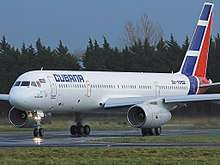
The Tu-204 cabin is available in several layouts, including the baseline single-class layout seating for 210 passengers and a two- or three-class layout designed for 164–193 passengers. A cargo version of the Tu-204 is being successfully operated by several airlines in Europe and Egypt.[5]
Seating configuration is 3-3 in economy and 2-2 in Business class. The business class cabin has a seat pitch of 810 millimetres (31.9 in). The passenger cabin can be divided into compartments according to class with removable bulkheads and curtains. Compartments are illuminated by reflected light. Hidden lights located over and under the overhead bins create uniform and comfortable illumination. Overhead bins for passenger baggage and coats are of the closed type. The volume of baggage per passenger is 0.052 cubic metres (1.8 cu ft).[6]
In 1994, the first certificate for Tu-204 aircraft (with PS-90A engines) was issued. Subsequently, issued certificates have extended estimated operational conditions and improved overall aircraft type design. The Tu-204-120 variant, certified with Rolls-Royce RB211-535E4 engines, complies with noise regulations described in Chapter 3 of Supplement 16 to ICAO, hence meeting all current European and ICAO requirements.[7] It is currently undergoing the certification process with JAA. The Tu-204-100 variant, certified with PS-90A engines, complies with noise regulations described in Chapter 4 of Supplement 16 to ICAO which means it is quieter. The aircraft was certified to Russian standards AP-25 (harmonized with FAR-25 and JAR-25).[8]
Technology
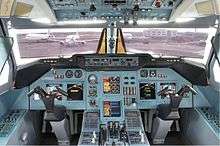
The Tu-204 is part of a new generation of Russian aircraft, including other recent developments such as the Ilyushin Il-96. The Tu-204 features many technological innovations such as fly-by-wire control systems, a glass cockpit, supercritical wings with winglets, and is available with Russian or foreign avionics.[9] The wings and tails are relatively resistant to ice build-up, and as such anti-icing systems are not equipped. Among today's airliners the Tu-204 is the only one which does not require wing anti-icing systems. During the test flight safety has been confirmed without the anti-icing system on the bearing surfaces and the aircraft obtained Russian and European certificates.[10]
Variants
Tu-204/204C
The Tu-204 is the basic passenger airline model, and the Tu-204C is the basic freight or cargo model. The most-used models are the -100C and the -120C.[11]
Tu-204-100/200
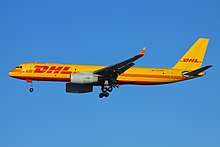
Certified in January 1995, this initial version is powered by Soloviev (now Aviadvigatel) PS90 turbofans with 157 kN (35,300 lbf) of thrust, and uses Russian avionics in addition to its Russian engines. The Tu-204-200 is a heavier version with extra fuel for more range. Only one was built by Aviastar-SP in Ulyanovsk but has not yet been delivered (RA-64036). Now this version is only produced by KAPO in Kazan, marketed under the designation Tu-214. The Tu-204-100C and Tu-204-200C are cargo versions of the −100 and −200 respectively, fitted with a forward main deck freight door. Currently, the Tu-204-100/200 is offered with the option of an up-rated Aviadvigatel PS90A2 turbofan, which promises 40% more service between overhauls.[12]
The Tu-204-100's maximum take-off weight (MTOW) is 107.5 tonnes, and its range with 196 passengers in a two-class configuration is 6,000 kilometres (3,700 mi).
Tu-204-120/220/120C/220C
To broaden product appeal, the Tu-204-120/220 offers non-Russian avionics and engines. It is powered by two Rolls-Royce RB211-535 engines, each with thrust of 192 kN (43,100 lbf). Egypt's Cairo Aviation became the debut operator in November 1998 when it took delivery of a Tu-204-120 and its cargo version the Tu-204-120C. The Tu-204-220 and Tu-204-220C cargo version, are a higher gross weight variants of the basic Tu-204-120.[13]
The Tu-204-120 has a maximum takeoff weight of 103 metric tons and a range of 4,600 kilometres (2,500 nmi) with 196 passengers in a two-class seating configuration.
Tu-204-300
A shortened, longer-range and more efficient derivative of the Tu-204, the Tu-204-300 is also known as Tu-234. About six meters (20 ft) shorter than the basic Tu-204, this variant is available in two versions: the longer-ranged, heavier version, powered by Aviadvigatel PS 90-A2 turbofans, has a maximum take-off weight of 107.5 metric tons and range (with 166 passengers) increased to 9,300 kilometres (5,000 nmi); and the lighter, shorter-ranged version, with a maximum take-off weight of 89 metric tons and range of 3,500 kilometres (1,900 nmi) with 166 passengers. The Russian airline Vladivostok Air is the debut customer. This airline's aircraft are in a two-class seating configuration, with a 142-passenger capacity. Average numbers of flight hours during each 24-hour period is 9.35 hours, for year 2009. It is also operated by Air Koryo which currently operates one Tu-204-100B and one Tu-204-300. The Тu-204s operate on the Pyongyang-Beijing, Bangkok, Vladivostok, Shenyang and Kuala Lumpur routes.[14]
Tu-204-500
This is a version of the Tu-204-300 optimized for shorter routes, featuring smaller wings and an increased cruising speed (to Mach 0.84), which makes it a competitor to the Next Generation Boeing 737. It is ETOPS rated, and fitted with a Honeywell 331-200ER APU.[15]
Tu-206
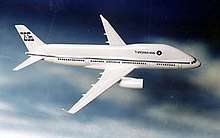
This variant is a company-funded testbed for alternative fuels, flying on liquefied natural gas[16]
Tu-214
The Tu-214 is also a variation of the Tu-204 first flown on 21 March 1996.[17] It is technically a Tu-204-200, one of the differences being that it is built by a different factory. Planes designated Tu-204 are produced in Ulyanovsk by Aviastar-SP; Tu-214 in Kazan by the Kazan Aircraft Production Association (KAPO).[18][19] Both factories are independent from the Tupolev design bureau and have some control over the design of the variant they produce.
The main difference is a full-size main door at the left side of the fuselage just before the wing. The Tu-204 has two main doors and 2 emergency doors; the Tu-214 has 3 doors and one emergency door.
The Tu-214 is essentially a higher gross weight variant of the Tu-204, being fitted with extra fuel tanks and structural adjustments to deal with the heavier gross weight. For this reason, the Russian government prefers to use it as the platform upon which all further modifications for the 'Special Mission' variants will be based. Some of the special mission variants are disclosed to be capable of a non-stop 10,000-kilometre flight range.[20]
As of July 2018, a total of 3 Tupolev Tu-214 aircraft are in airline service with Rossiya.[21]
Tu-214ON

Observation version of Tu-204-200 equipped for Treaty on Open Skies missions built by Kazan Aircraft Production Association. Vega Radio Engineering Corporation was contracted for the development of airborne surveillance system, ground-based complex and other mission equipment for the aircraft. It is equipped with one A-84ON panoramic camera, one AK-111 topographic camera and two perspective AK-112 digital aerial cameras to capture high-resolution aerial photography.[22] Two video cameras, a Raduga infrared thermographic camera and Ronsard Side looking airborne radar are also fitted.[23]
The first Tu-214ON (RA-64519) was demonstrated at the MAKS-2011 international air show in Moscow. It performed its first test flight on 1 June 2011, which was followed by a series of 24 flights by December 2011. The Ministry of Defence of the Russian Federation conducted state tests to verify the air and ground equipment of the Tu-214ON aircraft in April 2013. The jet was delivered to the Russian Defence Ministry on 22 August 2013. The second airliner (RA-64525) made its first flight on 18 December 2013 and was delivered on 4 July 2014.[24] The Tu-214ON is set to replace the Tupolev Tu-154 and Antonov An-30 aircraft in the role.[25]
Tu-214PU
Airborne command post version. Two operated for the Russian President.[26][27]
Tu-214SR
Communications relay version. 5 operated by GTK Rossiya for the Russian government.[26][28][29][30]
Tu-214SUS
Communications relay version for the Russian President. Two delivered.[26][30]
Tu-214R

Special-mission versions of the Tu-214 commercial transport aircraft, developed under the codename 'Project 141', to replace the Il-20 Coot ELINT platform. The aircraft are configured to carry the MRC-411 multi-intelligence payload, to include electronic intelligence (ELINT) sensors, side-looking Synthetic Aperture Radar (SAR) and other Signals Intelligence (SIGINT). In addition, the aircraft will carry multi-spectral electro-optical systems.[31] The aircraft has conducted test flights over the Sea of Japan but the programme experienced problems in January 2013. (Jane's Defence Weekly 16 January 2013)
The Tu-214R made its public debut in August 2013 at Moscow Air Show MAKS and was heralded as a platform for conducting surveillance of the U.S., in accordance with the Treaty on Open Skies, to monitor compliance with the relevant treaties.[32][33]
As of January 2015, two were conducting test flights with the Russian Air Force.[34]
In February 2016, Russia was reported to have deployed one Tu-214R to its base in Latakia, Syria.[35][36]
In July 2016, two flights have been reported to have been conducted near the Latvian, Estonian and Finnish borders, with the plane (registry reported as RA-64514) conducting close approaches a few dozen kilometers of the Finnish border on July 5 and 7.[37]
After Syria operation, the aircraft was declared combat-ready. One plane was redeployed to Syria in summer 2016.[38]
Tu-214PU-SBUS
Special-purpose aircraft-control point equipped with a special onboard communication unit SBUS-214 intended for the Ministry of Defence of Russia. The aircraft is built with Russian-made components only, meeting the requirements of the state customers and has a range of at least 7,200 km (4,500 mi). The main purpose of the aircraft is to provide additional communication capabilities to the user.[39] The Russian MoD placed an order for two aircraft in November 2015.[40] The first aircraft was delivered in March 2018[41] while the second in June the same year.[42]
Tu-204SM

The Tu-204SM, alternatively Tu-204CM,[43] a medium-range airliner, is an upgraded version of the Tu-204-100/300.[44][45] While the Tu-204SM will retain key design and aerodynamic features of the Tu-204-100/100E/100V series, there are numerous upgrades, largely aimed at meeting the current and near-future Russian and international standards, including those of ICAO and Eurocontrol.
The new cockpit features allow the Tu-204SM to be flown by a two-pilot crew (as compared with the three-pilot arrangement of the original Tu-204 series). These features include a new computer (VSUPT-85-2040), a new flight management system (ASO-204/FMS), wide LCD displays (KSEIS-204E), head-up displays (HUD), and an automated board system maintenance and diagnostic system. The electronic flight bag concept will be implemented and all controls and displays will be in English.
The Tu-204SM will be powered by two PS-90A2 engines. The latter is significantly improved over the original PS-90A power plants.[46] and features a unified twin-spool turbofan with a high bypass ratio. The PS-90A2 is expected a life cycle cost saving of 35% over the original engine with a simultaneous increase in reliability in the 50 to 100% range. The PS-90A2 is designed to meet the Russian AP-33 aviation standard, which is harmonized with the US FAR Part 33 and the European JAR33.
There will also be a new APU (TA-18 APU-200) and upgraded fuel management, hydraulic and fire safety systems.
The updated passenger cabin accommodates a maximum of 210 passengers or 174 in a typical two-class layout. The upgrades include[44][45] new larger storage bins, multicolored LED lighting, sound-absorbing structures and a modern in-flight entertainment system (IFE) .
The price for one Tu-204SM is estimated at USD 40–47 million.[47]
The first test flight of Tu-204SM was successfully carried out on 29 December 2010.[4] First deliveries of Tu-204SM were originally planned for 2011.[45] As of April 2015, no Tu-204SM aircraft have been delivered.
Tu-204SM orders
Red Wings Airlines will be the first airline to operate the Tu-204SM. Ilyushin Finance Co. (IFC) said it would complete negotiations with Red Wings for 44 Tu-204SM aircraft in February, to sign a firm order in March, 2011. Red Wings already operates a fleet of Tu-204-100 and Tu-204-100V jetliners, to which it added one airframe in 2010.[48] Russia's largest aircraft lessor, Ilyushin Finance, has previously placed Tu-204-100 aircraft with Cubana, Air Koryo and Red Wings, and Tu-204-300s with Vladivostok Avia and Air Koryo. Additionally, IFC leases three Tu-214s (Tu-204-200s) to Transaero. Faced with low production rates for the Tu-204 models, Tupolev asked component providers to lower their prices in order to cut the plane's overall price by 27–30%. These suppliers agreed, on condition that 44 more firm orders be secured for the Tu-204SM through 2016.
By January 2012 a firm order from Red Wings had not been signed, the stumbling blocks being requests for guarantees of the residual value of the airframes and after-sales support at a cost the same as an equivalent Airbus or Boeing model.[49] It was subsequently announced that Red Wings had cut back its initial commitment from 44 to 15 Tu-204SMs due to delays to the flight-test programme and after the lessor Ilyushin Finance reportedly "lost interest".[50]
A large order by Iran Air Tours is under threat because of sanctions against the Iranian economy, as the American company Pratt & Whitney has been involved in the development of the engine with the Perm Engine Company. Completing the sale by re-equipping the Tu-204SMs with the Tu-204's Russian-made PS-90A engines has been proposed.[51]
At the Singapore Air Show in 2016 the Vice President of the Russian United Aircraft Corporation stated that every company that has ordered the Tu-204 has gone bankrupt so there currently no orders for the Tu-204SM, and Tupolev has frozen on development work on the aircraft and the UAC will withdraw it from their list of aircraft prices as soon as the Irkut MC-21 comes to the market.[52]
Operators
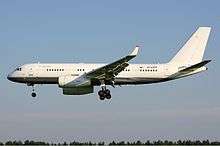
As of July 2018, there are 14 aircraft in commercial service.[21] Total users as of December 2016 include:
| Airline | Aircraft Type | In Service | On Order | Stored |
|---|---|---|---|---|
| 2 x 204-120C | 3 | 0 | 2 | |
| 204-100C | 1 | 0 | 1 | |
| 204-120F | 0 | 4 | 0 | |
| 204-120CE | 0 | 2 | 0 | |
| 204 | 4 | 2 | 4 | |
| 214 204–300 | 12 | 0 | 0 | |
| 1 x 204-100E | 3 | 0 | 1 | |
| 1x 204–300 1x 204-100 | 2 | 0 | 0 | |
| 204-100 | 8 | 0 | 0 | |
| 204-100C | 2[54] | 0 | 0 | |
| 204–300A | 1[55] | 0 | 0 | |
| Total | All versions | 36 | 8 | 8 |
Previous Operators
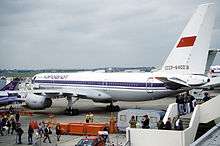
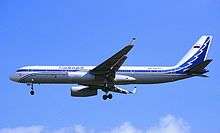
.jpg)
| Airline | Aircraft Type | Status | Year Retired | Notes |
|---|---|---|---|---|
| 204-100 | Delivered | 2005 | After the break-down, given to other airlines including Vnukovo Airlines | |
| 204-100/204SM | Order Canceled | 2010 | The airline planned to acquire some from parent airline Red Wings Airlines. Orders cancelled due to bankruptcy. | |
| 214 | Delivered | 2009 | Airline went bankrupt in 2009 | |
| 204-100 | Delivered | 2011 | Airline went bankrupt in 2011 | |
| 214 | Delivered | 2008 | Airline went bankrupt in 2008 | |
| 204-100 | Order Canceled | 2008 | Orders canceled due to bankruptcy | |
| 214 | Delivered | 2017 | Acquired from Transaero. Returned to leasing agency Tu-204 still in operation. | |
| 204-100 | Delivered | 2014 | Aircraft stored inactive | |
| 204-100 | Delivered | 2005 | Acquired after the bankruptcy of Vnukovo Airlines | |
| 214 | Delivered | 2015 | Launch customer of that type. Ceased operations in 2015 due to financial difficulties. | |
| 204–300 | Delivered | 2013 | Launch customer of type | |
| 204-100 | Delivered | 2001 | Launch customer. Airline went bankrupt in 2001 | |
Production by year
| Year | 1989 | 1990 | 1991 | 1992 | 1993 | 1994 | 1995 | 1996 | 1997 | 1998 |
|---|---|---|---|---|---|---|---|---|---|---|
| Produced | 1 | 1 | 2 | 2 | 5 | 2 | 1 | 3 | 1 | 1 |
| Year | 1999 | 2000 | 2001 | 2002 | 2003 | 2004 | 2005 | 2006 | 2007 | 2008 |
|---|---|---|---|---|---|---|---|---|---|---|
| Produced | 2 | 4 | 3 | 4 | 4 | 2 | 3 | 4 | 2 | 10 |
| Year | 2009 | 2010 | 2011 | 2012 | 2013 | 2014 | 2015 | 2016 | 2017 |
|---|---|---|---|---|---|---|---|---|---|
| Produced | 6 | 3 | 5 | 3 | 2 | 1 | 2 | 2 | 2 |

Specifications
| 204-100 | 204-120 | 214 | 204-300 | 204SM | |
|---|---|---|---|---|---|
| Cockpit crew | Three | Two | |||
| Seating capacity | 190 (1-class, standard) 172 (2-class, standard) 210 (maximum) | 210 (1-class, standard) 180 (2-class, standard) | 156 (1-class, standard) 142 (2-class, standard) | 194 (1-class, standard) 176 (2-class, standard) 215 (maximum) | |
| Seat pitch | 32 in (1-class, standard) 47 & 32 in (2-class, standard) | 32 in (1-class, standard) 39 & 32 in (2-class, standard) | 32 in (1-class, standard) 46 & 32 in (2-class, standard) | 32 in (1-class, standard) 38 & 32 in (2-class, standard) | |
| Length | 46.14 metres (151 ft 5 in) | 40.19 metres (131 ft 10 in) | 46.14 metres (151 ft 5 in) | ||
| Wingspan | 41.8 metres (137 ft 2 in) | ||||
| Wing area | 184.2 square metres (1,983 sq ft) | ||||
| Height | 13.9 metres (45 ft 7 in) | ||||
| Fuselage width | 3.8 metres (12 ft 6 in) | ||||
| Fuselage height | 4.1 metres (13 ft 5 in) | ||||
| Cabin width | 3.57 metres (11 ft 9 in) | ||||
| Cabin height | 2.16 metres (7 ft 1 in) | ||||
| Maximum take-off weight | 105,000 kilograms (231,000 lb) | 103,000 kilograms (227,000 lb) | 110,750 kilograms (244,160 lb) | 107,000 kilograms (236,000 lb) | 108,000 kilograms (238,000 lb) |
| Maximum landing weight | 88,000 kilograms (194,000 lb) | 93,000 kilograms (205,000 lb) | 88,000 kilograms (194,000 lb) | 89,500 kilograms (197,300 lb) | |
| Maximum payload | 21,000 kilograms (46,000 lb) | 25,200 kilograms (55,600 lb) | 18,000 kilograms (40,000 lb) | 23,000 kilograms (51,000 lb) | |
| Takeoff run at MTOW | 1,780 metres (5,840 ft) | 2,030 metres (6,660 ft) | 1,870 metres (6,140 ft) | 1,950 metres (6,400 ft) | |
| Service ceiling | 12,100 metres (39,700 ft) | 12,200 metres (40,000 ft) | |||
| Cruising speed | 810 to 850 km/h (500 to 530 mph) | ||||
| Maximum speed | 900 km/h (560 mph) | ||||
| Range (Max payload) | 4,300 kilometres (2,700 mi) | 4,100 kilometres (2,500 mi) | 4,340 kilometres (2,700 mi) | 5,800 kilometres (3,600 mi) | 4,200 kilometres (2,600 mi) |
| Maximum fuel capacity | 35,700 kilograms (78,700 lb) | 35,700 kilograms (78,700 lb) | 36,000 kilograms (79,000 lb) | 35,800 kilograms (78,900 lb) | |
| Engine (x 2) | Aviadvigatel PS-90A | Rolls-Royce RB211-535E4B | Aviadvigatel PS-90A | Aviadvigatel PS-90A2 | |
| Max. thrust (x 2) | 157 kN 16,000 Kgf; 35,274 lbf | 192 kN 19,000 Kgf; 43,100 lbf | 158.2 kN 16,140 Kgf; 35,582 lbf | 171.6 kN 17,500 Kgf; 38,581 lbf | |
Sources: United Aircraft Corporation,[57] Tupolev,[58] 204SM.[59]
Accidents and incidents
- On 22 March 2010, Aviastar Flight 1906, an Aviastar Tupolev Tu-204 tail number RA-64011, crash-landed short of the runway near Moscow's Domodedovo International Airport while attempting to land at night in fog and poor visibility. There were no fatalities, but four of the eight crew members were seriously injured. It was a repositioning flight with no passengers on board. In September 2010, the МАК released their final report into the accident.[60] The cause of the accident was attributed to pilot error, with a number of factors contributing to the accident including inadequate crew training and lack of cockpit resource management, failure of autoflight systems and serious regulatory violations by Aviastar-TU. Eight years earlier, the same aircraft experienced a flameout of both engines, glided and overran the runway at Omsk Airport and sustained minor damage.
- On 29 December 2012 at 16:35 local time (12:35 GMT), Red Wings Flight 9268, a Tupolev Tu-204-100В (RA-64047, c/n 1450743164047, s/n 047, built 2008) crashed on landing after overrunning runway 19 at Moscow Vnukovo International Airport (VKO) following a non-revenue repositioning flight originating from Pardubice Airport, Czech Republic. The aircraft broke up and came to a stop on elevated highway M3 about 400 meters (1,300 feet) past the runway's end. There were eight crew members on board of whom five were killed and the other three seriously injured.[61][62] Apart from those, one man driving his car on M3 highway was seriously injured when the detached Tu-204's nosewheel crashed into side of the car; the driver behind him recorded the impact on camera.[63] The fatal Vnukovo accident was the second runway overrun incident involving a Red Wings operated Tu-204-100B in nine days following a Moscow Vnukovo to Novosibirsk flight on 20 December 2012 that overran runway 25 at Tolmachevo Airport by 1,150 feet (350 meters) into an open field.[64] Flight data recorder readouts indicate that brake failure as well as engine thrust reverser issues were major contributing causes in both overruns resulting in the issuance of additional airworthiness directives.[65][66][67][68]
See also
Related development
Aircraft of comparable role, configuration and era
Related lists
References
- ↑ "Aviation News Magazine - Russian survivor – Tupolev's 204". Archived from the original on 23 September 2015. Retrieved 26 December 2014.
- ↑ Алексей Усанов. "✈ OKBTupolev ✈: Aircraft Tu-204". Retrieved 31 December 2016.
- 1 2 "Tu-204/214 Production list". RussianPlanes.net. Retrieved 31 December 2015.
- 1 2 "Новый опытный самолет Ту-204СМ совершил первый полет". Tupolev.ru. 29 December 2010. Archived from the original on 4 January 2011. Retrieved 31 December 2010.
- 1 2 "Tupolev Tu-204, Tu-214, Tu-224 & Tu-234". Airliners.net. Retrieved 30 September 2011.
- ↑ "Best seats Tupolev Tu 204 100". Seatmaestro.com. Archived from the original on 5 October 2011. Retrieved 30 September 2011.
- ↑ "Tu-204SM begins airworthiness certification programme". Flightglobal.com. Retrieved 30 September 2011.
- ↑ European Aviation Safety Agency (8 October 2008), Type Certificate Data Sheet for Noise, retrieved 29 December 2012 Archived 16 August 2011 at the Wayback Machine.
- ↑ "Civil Aviation". 10950.08sc.thinkquest.nl. 2 January 1989. Retrieved 30 September 2011.
- ↑ Кощеев А. Б.
- ↑ In Russian Archived 27 September 2011 at the Wayback Machine.
- ↑ "PSC "Tupolev" – TU-204-100". Tupolev.ru. Archived from the original on 27 September 2011. Retrieved 30 September 2011.
- ↑ "PSC "Tupolev" – TU-204-120C". Tupolev.ru. Archived from the original on 27 September 2011. Retrieved 30 September 2011.
- ↑ "PSC "Tupolev" – TU-204-300". Tupolev.ru. Archived from the original on 27 September 2011. Retrieved 30 September 2011.
- ↑ "Tupolev Tu-204". Awesome80s.com. Archived from the original on 28 September 2011. Retrieved 30 September 2011.
- ↑ "PSC "Tupolev" – Cryogenic aircraft". Tupolev.ru. Archived from the original on 26 November 2010. Retrieved 13 November 2010.
- ↑ "JSC "Kazan Aviation Production Association named after S.P.Gorbunov" | Our products". Oaokapo.ru. Archived from the original on 24 May 2013. Retrieved 16 August 2013.
- ↑ PSC «Tupolev» – MAKS 2005 Archived 5 February 2012 at the Wayback Machine.
- ↑ John Pike. "Kazan Aircraft Production Association (KAPO) n.a. Gorbunov - Russian Defense Industry". globalsecurity.org. Retrieved 3 July 2015.
- ↑ "Rossiya special aircraft division will acquire five Russian-produced aircraft - News - Russian Aviation". Ruaviation.Com. Retrieved 16 August 2013.
- 1 2 "World Airline Census 2018". Flightglobal.com. Retrieved 2018-08-26.
- ↑ "Tu-214ON (Open Skies) Reconnaissance Aircraft, Russia". AirForceTechnology. Retrieved 9 February 2016.
- ↑ "Russian Air Force Almanac 2015" (PDF). Air Force Magazine. Retrieved 9 February 2016.
- ↑ "Defence Ministry taking delivery of second Tu-214ON". Take Off. Archived from the original on 16 February 2016. Retrieved 9 February 2016.
- ↑ http://tass.com/defense/1022938
- 1 2 3 Mladenov, Alexander (May 2012). "Tu-214SUS Delivery Expected in 2012". Air International. Vol. 82 no. 5. p. 13. ISSN 0306-5634.
- ↑ Karnozov, Vladimir (10 November 2010). "Russian president takes first flight in new Tu-214PU". Retrieved 30 April 2012.
- ↑ "PICTURE: Russian special aviation squad adds Tu-214SRs". Flightglobal. 4 June 2009. Retrieved 30 April 2012.
- ↑ Mladenov, Alexander (March 2012). "Three more Tu-214SRs for GTK Rossia". Air International. Vol. 82 no. 3. p. 9.
- 1 2 "Два самолета спецназначения Ту-214ПУ-СБУС будут построены до конца года - Еженедельник «Военно-промышленный курьер»". vpk-news.ru.
- ↑ Eshel, Tamir. "Fielding of Russian Special-Mission Aircraft Delayed Until 2013–2014 | Defense Update – Military Technology & Defense News". Defense Update. Retrieved 13 November 2012.
- ↑ "На МАКС 2013 впервые публично покажут один из самых секретных самолетов России Ту-214Р". military-informant.com. Archived from the original on 12 February 2015. Retrieved 25 January 2015.
- ↑ "The Russian Air Force will receive another Tu-214 Open Skies Plane". Retrieved 26 December 2014.
- ↑ "TUPOLEV COMPLETES TEST FLIGHTS 2ND TU-204R SPY PLANE". AIRheads FLY. 1 November 2014. Archived from the original on 17 January 2015. Retrieved 12 January 2015.
- ↑ Аналитики обнаружили в Сирии секретный российский самолет-разведчик NEWSru, 16 Feb 2016.
- ↑ "Russia has just deployed its most advanced spyplane to Syria". 15 February 2016.
- ↑ "Tältä ei niin vain piiloudutakaan – Venäjän uusi supervakoilukone skannasi koko Suomen itärajan kahteen kertaan" [One does not simply hide from this - Russia's new spy plane conducts two scans of the entire Finnish east border]. Iltasanomat (in Finnish). 2016-07-11.
- ↑ Sputnik. "Russia's State-of-the-art Tu-214R Spy Plane Successfully Passes Syria Test".
- ↑ "Russia receives second Tu-214PU-SBUS airborne command-and-control post". Jane's Information Group. 25 June 2018. Retrieved 27 June 2018.
- ↑ "Построен первый самолет Ту-214ПУ-СБУС для Министерства обороны России". bmpd.livejournal.com. 18 October 2017. Retrieved 18 October 2017.
- ↑ "Министерство обороны России получило первый самолет Ту-214ПУ-СБУС". bmpd.livejournal.com. 3 April 2018. Retrieved 15 April 2018.
- ↑ "Russia receives second Tu-214PU-SBUS special-purpose aircraft". www.airrecognition.com. 21 June 2018. Retrieved 27 June 2018.
- ↑ .http://www.uacrussia.ru/en/aircraft/lineup/civil/tu-204sm/
- 1 2 "Presentation booklet on the aircraft Tu-204SM". Tupolev.ru. Retrieved 17 September 2013.
- 1 2 3 "Tupolev". aviaport.ru. Retrieved 23 December 2009.
- ↑ "First flight for PS-90A2 test-bed". uacrussia.ru. Archived from the original on 3 October 2011. Retrieved 17 October 2009.
- ↑ "Red Wings revives TU 204 Production". rt.com. Archived from the original on 18 July 2012. Retrieved 12 January 2011.
- ↑ "Ilyushin Finance and Red Wings negotiate on 44 Tu-204SM". ruaviation.com. Retrieved 20 January 2011.
- ↑ "Product support is hurdle to Tu-204SM deal: Lebedev". flightglobal.com. 20 January 2012. Retrieved 21 January 2012.
- ↑ "Red Wings weighs A321 as back-up to Tu-204SM". flightglobal.com. 20 March 2012. Retrieved 20 March 2012.
- ↑ "Американские санкции приземлили Ту-204СМ: Контракт на поставку самолетов в Иран оказался под вопросом :: РБК daily 15.04.2010". Rbcdaily.ru. Archived from the original on 24 July 2011. Retrieved 13 November 2010.
- ↑ "Russia's United Aircraft", Flight Global, 11 August 2009 .
- ↑ ""Авиастар-СП" планирует до 2014 г. поставить администрации президента РA 6 самолетов Ту-204-300 // АвиаПорт.Дайджест". Aviaport.ru. Retrieved 13 November 2010.
- ↑ "Почта России приступила к эксплуатации двух грузовых самолетов Ту-204-100С — Туполев". tupolev.ru.
- ↑ Business Aero Archived 24 July 2011 at the Wayback Machine.
- ↑ "Tupolev Tu-204 Production List". Archived from the original on 10 August 2015. Retrieved 26 December 2016.
- ↑ "UAC :: Performance". Archived from the original on 18 October 2014. Retrieved 26 December 2014.
- ↑ "Civil aviation". Archived from the original on 12 February 2015. Retrieved 26 December 2014.
- ↑ "United Aircraft Corporation Website". uacrussia.ru. Archived from the original on 3 October 2011. Retrieved 29 December 2010.
- ↑ "Accident: Aviastar-TU T204 at Moscow on Mar 22nd 2010, landed short of runway". 20 September 2010. Retrieved 12 June 2011.
- ↑ "ASN Aircraft accident Tupolev 204-100V RA-64047 Moskva-Vnukovo Airport (VKO)". Aviation-safety.net. Retrieved 29 December 2012.
- ↑ Agencies (29 December 2012). "Russian passenger jet crashes at Moscow's Vnukovo airport". Guardian. Retrieved 29 December 2012.
- ↑ "Возросло число раненных в крушении Ту-204 во Внуково". Life News. Retrieved 24 January 2013.
- ↑ "ASN Aircraft accident 20-DEC-2012 Tupolev Tu-204-100V RA-64049". Aviation-safety.net. 20 December 2012. Retrieved 29 December 2012.
- ↑ Hradecky, Simon "Accident: Red Wings T204 at Moscow on December 29th 2012, overran runway on landing" The Aviation Herald, 29 December 2012. (updated 31 December 2012).
- ↑ Hradecky, Simon "Incident: Red Wings T204 at Novosibirsk on December 20th 2012, runway excursion on landing" The Aviation Herald 20 December 2012 (updated 30 December 2012)
- ↑ Bad brakes cited in Moscow crash landing Agence France-Presse (via NDTV.com) 30 December 2012
- ↑ Kaminski-Morrow, David "Tu-204 directive warns pilots to check thrust-reverse status" Flightglobal.com, 2 January 2013
External links
| Wikimedia Commons has media related to Tupolev Tu-204. |
| Wikimedia Commons has media related to Tupolev Tu-214. |